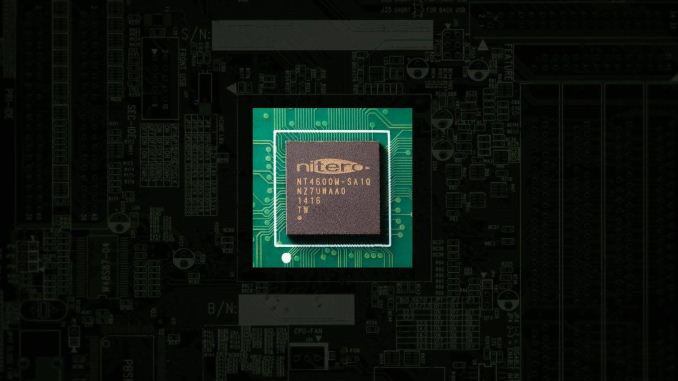WiGig Startup Nitero Launches NT4600 802.11ad Solution for Mobile Platforms
by Ganesh T S on July 16, 2014 7:00 PM EST
We have looked at multiple 60 GHz 802.11ad solutions from Wilocity over the last couple of years. A couple of weeks back, this market area received a fillip as Wilocity was bought by Qualcomm for around $300 million. Wilocity's chipsets are currently integrated inside a few business laptops from Dell, pointing to WiGig taking off after more than four years of development. With Qualcomm behind the technology now, it is quite likely that Wilocity's latest mobile-usage targeted products will integrate into a future Snapdragon platform. In this market state, we have a new startup that is pitching its first solution for WiGig.
Nitero, a fabless semiconductor company, is launching the NT4600 802.11ad solution today. Instead of starting off with the PC as a target platform, Nitero has designed this in Samsung's 28nm RF process to achieve 10x lower power consumption numbers compared to currently existing WiGig solutions for PCs. The implication is that the NT4600 can be directly used in tablets and smartphones.
The NT4600 supports TX/RX beamforming for operation even in non-line of sight conditions. It supports data rates up to 4.6 Gbps and provides a PCIe host interface for connecting to the app processor. Nitero also has Android drivers ready for their platform. The company is demonstrating the NT4600 to prospective customers now, with mass production expected in early 2015.
Source: Nitero










12 Comments
View All Comments
willis936 - Thursday, July 17, 2014 - link
That bandwidth is enough for 1080p60 8bpc on a good day. Is that 4.6Gbps number like a 11g's 54 Mbps? Also this beamforming thing sounds interesting. How would the antennas be placed on something like a phone? I assume range will still be pretty limited. I wouldn't expect more than 10 feet in the open or 3 feet with something in the way.nathanddrews - Thursday, July 17, 2014 - link
I'm pretty excited about AD as I've chosen to forego AC entirely. Must... hold... out...ganeshts - Thursday, July 17, 2014 - link
They are for different applications. ac is in the 5 GHz band - more range and not in-room technology - compared to ad which is in the 60 GHz band. Look at the type of usecases enabled by Wilocity in the Dell business laptop - http://accessories.us.dell.com/sna/productdetail.a... (this is the dock with 802.11ad support that can talk to the notebook on the other side - list of supported models at the bottom of the above link)Guspaz - Thursday, July 17, 2014 - link
WiGig is ultra-short-range wireless... It doesn't compete with or replace AC at all...nathanddrews - Thursday, July 17, 2014 - link
Assuming you only have one router/AP.I'd like to see how it performs IRL. With beamforming, wall composition, and interference, most wireless technologies perform differently in-home. Sometimes better than expected, sometimes worse.
e36Jeff - Thursday, July 17, 2014 - link
You would need a router/AP for every room of your house to do 802.11ad as an ac replacement. The people developing AD have stated it is not an AC replacement. Part of the AD specification states that when you leave the room that the router is in it drops back to AC as the AD signal will fail. On top of that, you'll have to connect all the AP's with 10Gbps connections or you won't be any faster than AC because your connection speed is only as good as the slowest link, which would be the 1Gbps ethernet cable in an AD environment. Based on what I'm reading about AD, I question if there will even be 802.11ad routers as that not what they are stating they will use the protocol for, and it is poorly suited for that environment given its signal limitations.e36Jeff - Thursday, July 17, 2014 - link
AD will not be able to go through a wall(it might be able to get through a paper-thin wall though), its not going to be a replacement for AC for a whole-home network. Hell, even 5Ghz has some issues with walls. AD is to replace the wires between your case and the peripherals, as well as peer-to-peer connections when in close proximity. AC will still be the method by which your PC, tablet, cell phone, and console connect wirelessly for a while. At the moment AC can far exceed your average internet connection, even in countries where the average internet connection is absurdly fast.e36Jeff - Thursday, July 17, 2014 - link
Additionally, after doing a bit of reading, if you are holding out for the actual 802.11ac replacement, you need to wait for 802.11ax. Its in super-early development, but is the successor to AC and is looking to provide up to 4x the connection speeds in a whole-home network solution.DanNeely - Thursday, July 17, 2014 - link
How're they planning to do so? Higher QaM levels? More spatial streams? Wider channels? Tighter beam forming to maintain higher signal strength at longer distances? Something else?I'm hoping wider channels isn't part of it; ac already supports up to 160 mhz, and with channels that wide the 5ghz band is already about as crowded as 2.4ghz is with 20 mhz channels.
e36Jeff - Thursday, July 17, 2014 - link
About all that is known about 802.11ax at this point is its name and that they want it to replace ac and be 4x faster. It's still super-early in its dev stage, and they aren't even sure what all frequencies it may use. The white paper I found on it seems like they aren't going to be increasing the max theoretical throughput, but actually working on increasing the real-world throughput in a heavily load environment. It mentions that, in addition to 2.4 and 5Ghz, they may use other frequencies between 1 and 6Ghz if they become available.